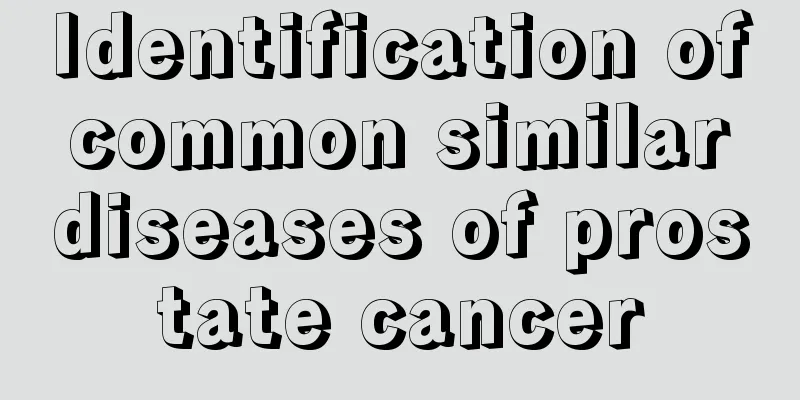Identification of common similar diseases of prostate cancer

|
Prostate cancer is a common type of malignant tumor in men, but there are many diseases similar to prostate cancer clinically. They must be carefully distinguished. Otherwise, if misdiagnosed, it will not only aggravate the condition but may also be life-threatening. Prostate cancer is one of the main causes of cancer death in men in Europe and America. The incidence rate increases with age. Half of the prostates of men over 80 years old have cancer lesions, but the actual number of clinical cases is far lower than this number. There are obvious regional and racial differences in the incidence of prostate cancer. According to statistics, the incidence rate is lowest in Chinese, highest in Europeans, and between Africa and Israel. my country and Japan are low-incidence areas for prostate cancer, but the number of latent cancer lesions found in autopsy of prostate segment sections of men over 50 years old is similar to that in Europe and America. Therefore, some people believe that cancer grows slower in Orientals than in Westerners, and there are fewer clinical cases. There are many diseases with similar clinical symptoms of prostate cancer, so how should they be distinguished? 1. It should be differentiated from prostate hyperplasia: The two are generally easy to distinguish. However, in the hyperplastic prostate glands, the epithelial cells in some areas are atypical in morphology and can be mistaken for cancer. The key points of differentiation are: the alveoli in the hyperplastic glands are larger, the surrounding collagen fiber layer is intact, the epithelium is double-layered and high-columnar, the cell nucleus is smaller than that of prostate cancer patients and is located at the base of the cell, and the glands are arranged regularly to form obvious nodules. 2. Differentiation from prostate atrophy: Prostate cancer often starts from the atrophic part of the gland, so it should be carefully differentiated. Atrophic alveoli are sometimes tightly clustered, atrophic and smaller, and the epithelial cells are cubic with large nuclei, which is very similar to cancer. However, this type of atrophy often involves the entire lobule, the collagen connective tissue layer is still intact, the matrix is not invaded, but it itself is sclerotic and atrophic. 3. Differentiation from prostate squamous epithelium or transitional epithelium metaplasia: It often occurs in the healing part of the infarct area within the gland, and the squamous epithelium or transitional epithelium is well differentiated without degeneration or splitting. The most prominent feature of metaplasia is ischemic necrosis or fibrous connective tissue matrix lacking smooth muscle. 4. Granulomatous prostatitis: The cells are large and can aggregate into sheets. They have transparent or light red stained cytoplasm and small vesicular nuclei, which are very similar to prostate cancer, but they are actually macrophages. Another type of cells is polymorphic, with condensed nuclei, vacuolated, small in size, arranged in rows or clusters, and sometimes some acini can be seen. When distinguishing, it should be noted that granulomatous prostatitis rarely forms acini, and the relationship between the lesions and normal glandular ducts remains unchanged. Degenerative amyloid bodies and multinucleated giant cells are often seen. The cells of prostate cancer are low columnar or cubic, with clear cell walls, dense eosinophilic cytoplasm, larger nuclei than normal, and may have variations in staining and morphology, and inactive division. Its acini are small, lack of curved tubules, completely lose the normal arrangement morphology, irregularly infiltrate the matrix, and the collagen connective tissue layer no longer exists. The acini contain a small amount of secretions, but rarely amyloid bodies. If prostate cancer undergoes obvious degeneration, the tissue structure will completely disappear, and there will be no tendency for acini to form. Warm reminder: It is very necessary to do a good job of distinguishing cancer. Cancer treatment is generally troublesome, so care must be taken to avoid misdiagnosis during the treatment process. Otherwise, not only will the treatment effect be poor, but there may also be other side effects. |
<<: These 5 factors increase the risk of prostate cancer
>>: What are the typical complications of prostate cancer
Recommend
What are the symptoms of advanced gallbladder cancer
Symptoms of late-stage gallbladder cancer include...
Office workers beware: Be careful of "overwork obesity" if you sit for a long time
The extra pressure in modern society has not only...
Does cupping for weight loss require exercise
Cupping for weight loss is currently a very popul...
What are the specialties of Hezhang, Guizhou?
Many people may not know where Hezhang County is....
What does chronic disease management of advanced lung cancer mean? How can patients with advanced lung cancer be effectively treated?
Lung cancer is one of the common malignant tumor ...
What are the symptoms of facial mask allergy? Uncomfortable reactions to facial masks and solutions
Although facial mask is a skin care product, vari...
People at high risk of lung cancer should undergo chest CT every year
For many lung cancer patients, when the disease i...
What are the chemotherapy drugs for colon cancer
Chemotherapy drugs for colorectal cancer have cer...
Cerebellar vermis tumor
Any tumor in the body is very painful for people ...
How to detect the signs of laryngeal cancer early
Only by understanding some typical symptoms of la...
Which hospital can treat lymphoma
Which hospital can treat lymphoma? We know that l...
What is a heat cold and what are the symptoms
I believe everyone is familiar with heat cold, be...
Can I eat dragon fruit if I have hemorrhoids?
Dragon fruit is a very common fruit in people'...
There is a long hair on my arm
In life, we will find that some people have parti...
Why do hemorrhoids bleed?
Hemorrhoid bleeding is a common symptom, so most ...









